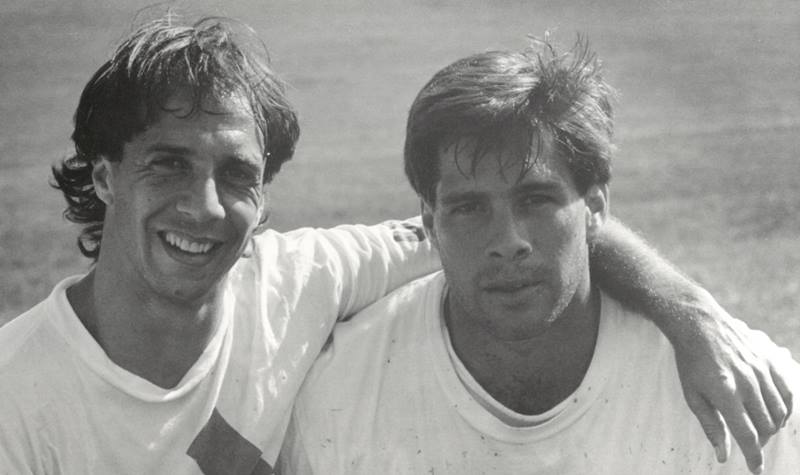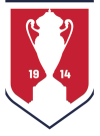Remembering Fernando Clavijo




Take the classic American dream. Now add soccer.
That was Fernando Clavijo. An immigrant to this land, he rode that dream – soared on it, really – to grand places. He rode to the very tip-top for almost every professional soccer dreamer, into a World Cup. Later he rode that dream to a career in management and administration as well as the National Soccer Hall of Fame.
That life, rich in soccer and in even richer in personal relationships, was in evidence as tributes poured forth for Clavijo last weekend. They mostly arrived along social media, but also elsewhere, as with the moment of silence before FC Dallas lined up to meet Bayern Munich’s reserves in a preseason friendly.
The former U.S. international and, most recently, FC Dallas’ technical director, passed away on Feb. 8 at his home in Fort Lauderdale. Diagnosed with multiple myeloma five years ago, he had continued to work for the Major League Soccer club until late last summer. He was 63.
Any player would be proud to have achieved what he did in the game: Clavijo was capped 61 times for the United States, including his spot on the U.S. roster for the 1994 FIFA World Cup. The oldest player on the roster at age 38, Clavijo started three tournament matches, on guard at right back for the team’s shocking first round upset against Colombia. History was indeed made on that June day at the Rose Bowl, and he was front-and-center in it.
Alexi Lalas, a teammate on that squad, remembers Clavijo as a tenacious tackler, truly a destructive force along the back line – but one of those soccer players who was a completely different human being outside the white lines. “He was a gentle soul, and a guy who loved playing soccer, loved the game,” Lalas said this week from his Southern California home, not far from where he trained daily with Clavijo in the long run-up to the 1994 World Cup. “He was certainly someone who appreciated every single moment the game gave to him.”
After the World Cup, Clavijo solidified his spot as a member of the National Soccer Hall of Fame, as head coach of the New England Revolution and later for the Colorado Rapids before moving into the front office with FC Dallas.
Yes, all that would suffice to ensconce himself U.S. Soccer history. But his trajectory toward those rewards of the game were anything but typical, and that’s what makes his story extra special.
Immigrant anonymity to international prominence
Clavijo was a fully professional player in his native Uruguay by age 16, and soon after began scanning for opportunities in lands beyond. By the time he was married and into his early 20s, Clavijo definitely wanted to expand his personal soccer world. Alas, he was boxed in by some byzantine rules in Uruguayan soccer at the time, significantly restricted in his ability to move abroad.
Frustrated, he quit the game. At age 22, he was ready for something different, something greater than professional soccer could offer in his native land.
So his humble-beginnings story began like so many others: with a move to the United States and a dream of something more. He and young wife Martha settled in New Jersey, where Clavijo worked as a busboy and played soccer in the park on weekends. That’s where Martha picked up the story, as told to FCDallas.com last year.
Clavijo taking on his native Uruguay on May 5, 1991 in Denver, Colo.
“One day playing soccer with an Italian team at a park in New Jersey, these other Italian guys came and asked him his name,” she said. “That was the beginning of a chain of events, because that Italian knew another Italian who knew another Italian and that other Italian had a soccer team. And that's how it all unfolded. Just from someone that saw him in a park in New Jersey.”
One thing led to another and Clavijo eventually made good use of a tryout for the New York Apollos of the American Soccer League. Indoor soccer was catching on through the 1980s, so Clavijo’s second stop was the New York Arrows of the thriving Major Indoor Soccer League. Clavijo excelled as a defender, helping the Arrows and, later, the powerful San Diego Sockers claim four MISL championships in six seasons.
All of that helped him gain notice from U.S. national team coach Bora Milutinovic, the Serbian tactician who was charged in 1991 with cobbling together a team that could adequately represent the American game during the 1994 World Cup. It was no easy task, as there was still no major professional outdoor league at that time. (Major League Soccer, in its nascent planning stages through the early 1990s, would not actually launch until 1996.)
So Milutinovic began assembling a mish-mash of college players, professionals from the shoestring-budget American Professional Soccer League and, yes, even indoor soccer. Of that group, Clavijo was quite important. He was already older than most of the players, 38 years old during World Cup USA 1994. Even then, however, Clavijo was among the team’s fastest players.
Marcelo Balboa was positioned nearby along the U.S. back line that summer. The longtime U.S. center back remembered how his early suspicion – here was a guy who was potentially a threat to take Balboa’s starting spot in defense – melted away as he came to know Clavijo’s humility, his easy-going spirit and obvious love for the game.

“When he comes [into the team], let's be honest, he was like a father figure to most of us because he was older and the experience he had with the San Diego Sockers and the championships he'd won with them. The one thing that pissed everyone off was that he was older than all of us, but he was faster than all of us.”
Even before the 1994 World Cup, Clavijo was leaving his mark on the U.S. scene.
The back line was being built in 1992 around a pair of twin center back hammers, Balboa and Lalas. But it all took a detour when Balboa tore his ACL during a friendly against Iceland in April 1993. He later acknowledged how rehabilitation that year was such a long, frustrating haul. There were days when he wanted to give up – but Clavijo was there and determined not to let him.
“I think that's more and more how our friendship grew and got stronger,” Balboa said. “We became roommates and as a young professional who thought he knew the whole world of soccer, he straightened me out pretty quick on how life is and how a professional acts.”
Fernando Clavijo tackling tough in a match against Romania on Feb. 6, 1993 in Santa Barbara, Calif.
That was off the field. But Clavijo certainly knew how to leave a mark on match day, as well. Figuratively and quite literally, it seems.
“He was a force of destruction that would take out the ball, the player and the first 10 rows of a stadium on a consistent basis,” Lalas said. “He was a lethal hatchet man in terms of the tackles he would put in. But he was also fast enough that he could make up for any mistakes. Not just his, but any mistakes that we made as center backs.”
“He tackled harder than a lot of guys double his size,” Lalas said. “Marcelo and I certainly appreciated that.”
There are surely lots of stories, telling anecdotes, quips etc., en route to gathering up 61 caps, as Clavijo did. Just as surely, the shining moment above all came June 22, 1994, as hard evening shadows and 93,000-plus filled Pasadena’s Rose Bowl. Clavijo lined up at right back against Colombia, a pre-tournament favorite, largely due to exquisitely skilled playmaker Carlos Valderrama.
Clavijo (bottom row, second from the left) in the U.S. Starting XI that faced Colombia on June 22, 1994 at the Rose Bowl
Cle Kooiman was a media favorite and a highly regarded teammate for his pump-it-up enthusiasm. Kooiman had started in the team’s World Cup opener, a 1-1 draw with well-regarded Switzerland. Now up against an even stronger team, Milutinovic surmised that he needed something different at right back, a faster set of feet to deal with speedy forward Faustino Asprilla. U.S. fans and media were shocked when they saw a starting 11 without Kooiman. With a little double-teaming help from Lalas, the U.S. back line kept Valderrama, Asprilla and the rest at bay for 89 minutes, eventually securing the 2-1 upset. It was easily the foremost group-stage shocker of the ’94 tournament.
More than just helping to frustrate Asprilla, Clavijo had an important clearance in the match, earliest to a loose ball during a hold-your-breath moment, a first-half flurry in front of Tony Meola’s U.S. goal.
"Bora called it," Kooiman said after the match, referring to the defensive switch. "The man's a miracle worker. He knew exactly what to do. I don't start, he puts Fernando in there because he's very quick. … Fernando came in and did a great job.
"It was Bora's call, and if he [Clavijo] can keep doing it, more power to him,” Kooiman continued. “I'm a team guy. Today, I'm just happy to be here, to be on the team. I sat on the bench, but right now, I feel like I played an entire game. I got chills out there. Near the end, I felt like crying."
That victory still stands among the most historic in U.S. Soccer history, right along with the 1989 win in Trinidad (that propelled the United States into its first World Cup in decades) and the 2002 World Cup elimination match against Mexico, along with perhaps a couple of others. Thanks largely to that emotionally charged afternoon at the Rose Bowl, the United States did indeed progress into the second round.
Clavijo and Romario during the USA's Knockout Round match against Brazil on July 4, 1994 in Palo Alto, Calif.
Clavijo was again on the field two weeks later against Brazil – he made the pass to Tab Ramos and then was first on the scene to assist his fallen teammate, shoving Brazilian attacker Leonardo, whose vicious elbow to the head had just finished Ramos for the day and nearly for his career – as the United States was eliminated in the second round on Independence Day.
Still, passage into the second stage, the Round of 16, had been the primary U.S. goal all along, the generally accepted marker for success that summer. The Knockout Round achievement was a sort of benchmark that helped validate the United States as a deserving World Cup host. Every member of that team, staff and players alike, played an important role in helping the sport in the United States climb that critical rung; Clavijo, the oldest among an otherwise youthful squad, certainly did his part.
All of that, from a guy whose first job in the United States was as a busboy. “What he made of himself was no surprise to those of us who knew him,” Lalas said. “But it was still an incredible story.”
Into Major League Soccer
As Clavijo was past his ideal playing age, he moved quickly into coaching after that 1994 World Cup experience. In fact, coaching was already being sewn into his soccer DNA; Clavijo had served as player coach in 1991 with the (indoor) St. Louis Storm. By the end of 1994 he was head coach of the Seattle SeaDogs of the Continental Indoor Soccer League. Three years later, still in Seattle, he was named CISL Coach of the Year.
Brian Schmetzer, long before he would win an MLS Cup as manager of Seattle Sounders FC, was one of Clavijo’s players with the SeaDogs.
Clavijo’s obvious move from there was back to the outdoor game, where Major League Soccer was planting its spindly roots through the mid-1990s. Clavijo first rejoined his old professor, Milutinovic, serving as an assistant on Nigeria’s 1998 World Cup team. He followed Milutinovic to MLS in 1999 as they paired to coach the league’s high-profile MetroStars. From there Clavijo struck out on his own, assuming the New England Revolution manager’s seat in time for the 2002 season.
Following two and half years at Gillette Stadium and a brief spell coaching Haiti’s national team, Clavijo took his second MLS head coaching appointment, this time with the Colorado Rapids. His first season with the Rapids (2005) was also the year Clavijo was inducted into the National Soccer Hall of Fame. His team at Colorado finished third in the league’s Western Conference and upset higher-seeded Dallas in the playoff’s first round.
Clavijo with fellow 2005 Hall of Fame inductees Hank Steinbrecher, Marcelo Balboa, Tab Ramos and John Harkes
By 2008 he was done with coaching and, four years later, moved into the front office as FC Dallas’ technical director. Clavijo did his part in helping collect young talent from South America and beyond (Fabian Castillo and Mauro Diaz most notably) while also nurturing and mentoring a wellspring of skillful young players rising through the club’s vanguard academy.
U.S. international Kellyn Acosta was one of those players that Clavijo helped along the way, and was among the many players who expressed their heartfelt sentiment along the social media byways: “RIP Fernando! Thanks for believing in me and giving me the opportunity to become a professional. You’ll be greatly missed. Fly high Fer”
Higher up in the FC Dallas organization, club president Dan Hunt had similar words of high praise for someone who practically counted as family.
“Fernando was a soccer pioneer,” Hunt said. “His knowledge and passion for the sport were unparalleled. While he was a phenomenal soccer mind, he was an ever better person who brightened the day of everyone he met. This is a sad time for the FC Dallas family and the entire soccer community.”




